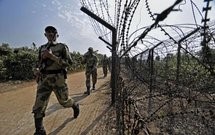 With the longstanding land boundary agreement (LBA) between India and Bangladesh on the verge of being clinched, the exchange or transfer of population residing in the enclaves (‘chhintmahals’) to be exchanged between the two countries is yet another problem they need to resolve.
With the longstanding land boundary agreement (LBA) between India and Bangladesh on the verge of being clinched, the exchange or transfer of population residing in the enclaves (‘chhintmahals’) to be exchanged between the two countries is yet another problem they need to resolve.
The question of giving options to the inhabitants residing in these enclaves needs to be addressed sooner than later to have a holistic resolution of this long-pending issue. Incidentally, both India and Bangladesh conducted a joint census between 14-17 July 2011 to determine the total population in these enclaves and found their number to be around 51,549. Of them, 37,334 persons were in Indian enclaves within Bangladesh while 14,215 people were residing in Bangladesh enclaves within India.
Historically speaking, the international boundary between India and Bangladesh was drawn hurriedly when the British left India. As a result thereof, thousands of people were left stranded in a number of unsettled enclaves as citizens of one country but living in territories surrounded by that of the other. The people in 111 Indian enclaves (17,160.63 acres) in Bangladesh and 51 Bangladeshi people (7,110.02 acres) in India have been living in these pockets without any rights as lawful citizens of either country.
It is learnt that India’s Parliamentary Standing Committee on External Affairs (SCEA) has proposed in its report to the Lok Sabha that the inhabitants living in Bangladeshi enclaves in India should be granted Indian citizenship under Section 7 of the Indian Citizenship Act, 1955 (as applicable to populations residing in territories incorporated into India), as these enclaves are to be transferred to India as part of the proposed land swap deal. As a result of the proposed LBA, not only would some Indian citizens return to the mainland from the previously held enclaves, but a number of currently Bangladeshi nationals would be given Indian citizenship after the area is ceded to India. After all, it is only logical that the Indian citizens living in Indian enclaves inside Bangladesh are given a choice to retain their Indian citizenship after these territories are legally handed over to Bangladesh.
Similarly, it is also advisable that the Bangladeshi citizens living in enclaves to be handed over by Bangladesh to India are also given an option to opt for Indian citizenship. If the same does not happen, the life of these people shall continue to be as troubled as it was earlier. It would also constitute a gross anomaly as being Bangladeshi citizens, they cannot continue to live in territories owned by India unless they are resettled in legally-owned Bangladeshi territories to be identified for the purpose or are given a choice to switch their citizenship without any need to change their place of residence i.e. current Bangladeshi enclaves encircled by Indian territories.
As the proposed territorial and population exchanges shall have serious implications for the country’s security and integrity, the government should exercise all options available to put in place a suitable mechanism and modality to check for the bonafides and credentials of the Bangladeshi nationals who shall be conferred Indian citizenship after legal incorporation of the enclaves where they have so far been residing as citizens of Bangladesh.
The SCEA, therefore, rightly observed that the cognate security aspects should be thoroughly examined before the proposed population exchange is effected. It also recommended suitable augmentation and upgradation of the law and order machinery in the affected areas in consultation with India’s eastern provincial government of West Bengal.
It may be noted that because of the fact that these Bangladeshi enclaves are deep within Indian territory without any fencing or means to physically demarcate them, the Bangladeshi citizens in these enclaves have been practically free to mix with the rest of the Indian populace. In fact, there is no choice available to these people as they are physically encircled on all sides by Indian territories. Such a scenario makes it very difficult for the Indian law enforcement authorities to effectively carry out their duties in these enclaves as technically they are not Indian territories, notwithstanding the fact that many of these enclaves have become hot-beds for criminal activity. It is this anomalous situation that the proposed LBA and its attendant Protocol seek to address as and when they are ratified and implemented by the two countries.
The Indo-Bangladesh LBA is a low-hanging fruit waiting to be plucked at the asking of the two countries. It is hoped that resolution of this issue would pave the way for the further strengthening and consolidation of a very functional bilateral relationship between the two countries. It is also hoped that such an agreement would encourage resolution of various other intractable issues between and India’s other neighbours.
The views expressed in this article are the author’s own and do not necessarily reflect those of the Government of India.
By Special Arrangement with Institute of Peace and Conflict Studies (http://www.ipcs.org)